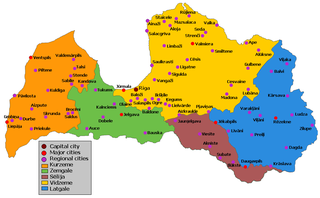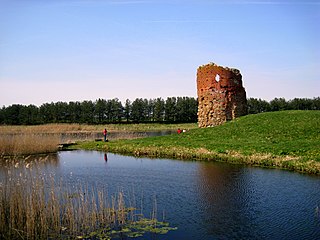
Courland is one of the Historical Latvian Lands in western Latvia. The largest city is Liepāja, the third largest city in Latvia. The regions of Semigallia and Selonia are sometimes considered as part of Courland as they were formerly held by the same duke.

Kuldīga is a town in western Latvia. It is the center of Kuldīga Municipality with a population of approximately 13,500.

Jelgava is a city in central Latvia about 41 kilometres southwest of Riga with 55,972 inhabitants (2019). It is the largest town in the region of Zemgale (Semigalia). Jelgava was the capital of the united Duchy of Courland and Semigallia (1578–1795) and the administrative center of the Courland Governorate (1795–1918).

Aizpute is a town in western Latvia's Aizpute Municipality in the valley of Tebra River, 50 km (31 mi) northeast of Liepāja.

Ilūkste is a town and a seat of Ilūkste Municipality, southeastern Latvia. The population in 2020 was 2,216.

Curonian Kings are a Latvian cultural group, originally lesser vassals and free farmers that lived in seven villages between Goldingen (Kuldīga) and Hasenpoth (Aizpute) in Courland.

The Bishopric of Courland was the second smallest (4500 km2) ecclesiastical state in the Livonian Confederation founded in the aftermath of the Livonian Crusade. During the Livonian War in 1559 the bishopric became a possession of Denmark, and in 1585 sold by Denmark to Poland–Lithuania.

The Livonian Crusade refers to the various Christianization campaigns in the area constituting modern Lithuania, Latvia and Estonia during the Papal-sanctioned Northern Crusades. It was conducted mostly by Germans from the Holy Roman Empire and Danes. It ended with the creation of the Terra Mariana and Duchy of Estonia. The lands on the eastern shores of the Baltic Sea were the last corners of Europe to be Christianized.

Alsunga is a village in Alsunga Municipality, Latvia. Alsunga is the center of the Suiti, a small Catholic community in the Lutheran western part of Latvia. There are approximately 1345 inhabitants in Alsunga.

Pāvilosta is a small port town in Latvia located at the mouth of Saka river in Courland. The population in 2020 was 881.

Piemare was one of the main Curonian kihelkonds with an administrative center in Esestua (Seeburg) before the 13th century. It was located between Bandava, Duvzare and the Baltic Sea on the territory of present Liepāja district in Latvia. For the first time, the territory was mentioned in the memorandum between Lammekinus, king of Esestua and Baudouin of Aulne Abbey, cistercian monk, vicelegate of Pope Gregory IX on 28 December 1230. Toponyms were named in partition agreement between the Bishop of Courland and the Livonian Order in 1253. The territory included the following settlements : Vārtaja, Tadaiķi, Ūsaiķi, Ilga, Līpa, Gavieze, Vārve, Padone, Peke, Okte, Ģelži, Lindale, Troista, Ievade, Dzēre, Boja, Droga, Krote, Apriķi, Ilmede, Diždupļi, Mazdupļi, Grobiņa, Neres, Stroķi, Tāši, Aistere, Vērgale, Rīva, Medze, Līva, Razge, Perkone, Dunalka, Prūši, Karkele, Dzintere, Saliena and Saka.

Bandava - and old Curonian land which existed in the territory of the Latvia during the late Iron Age until it was conquered and divided in 1253 by Bishopric of Courland and Livonian Order.

Grobiņa Castle is a medieval castle located in the town of Grobiņa, Latvia, in western Courland. The ancient Curonian castle hill is located only 100 m from the castle. It is supposed to be the famous Seeburg, which is mentioned in Scandinavian sources as early as the 9th century.

The ruins of Embūte Castle are located in Embūte, Latvia, in Embūte Parish, Vaiņode Municipality, not far from an ancient hillfort erected by Curonians. It was an ancient Curonian settlement and is mentioned in ancient chronicles as a place with strong Curonian resistance to German crusaders. The bishop's castle was built as a border castle with Lithuania by Livonian Order on a steep hill on the right bank of the Lanka river, which flows into left tributary of the Venta. Later manor house was built using the walls of the former castle, which can be seen in the division of the rooms and the building material. Today, the ruins are surrounded by trees and are in poor condition.

Jaunauce Manor is a manor house in Jaunauce parish in Saldus municipality in the historical region of Courland, in western Latvia.

Bēne Manor is a manor house in Bēne parish, Auce Municipality in the historical region of Zemgale, in Latvia. Bēne manor was established at the end of the 16th century, upon collapse of the Livonian Order and formation of the Duchy of Courland.

Aizpute Castle is a Livonian Order castle in the town of Aizpute in the historical region of Courland, in western Latvia. It was heavily damaged during the Second Northern War (1655–1660). Since 1998, the castle ruins are a Latvian historical monument.

Dobele Castle is a castle in the town of Dobele on the west bank of the river, in the historical region of Zemgale, in Latvia. Dobele was built in 1335 by the Livonian order on top of a more ancient castle.

Piltene Castle is a Bishopric of Courland castle in the town of Piltene in the historical region of Courland, in western Latvia. Until the 16th century it served as a capital of Bishopric of Courland.

Kuldīga Castle also Goldingen Castle and Jesus Castle was a medieval castle of the Livonian Order in historical Courland in town Kuldīga near Venta Rapid. Today on the left bank of the Venta at the end of the old bridge one can find the former castle mill, a castle guard's house and a city park with the castle ruins on Rumba Hill.






















